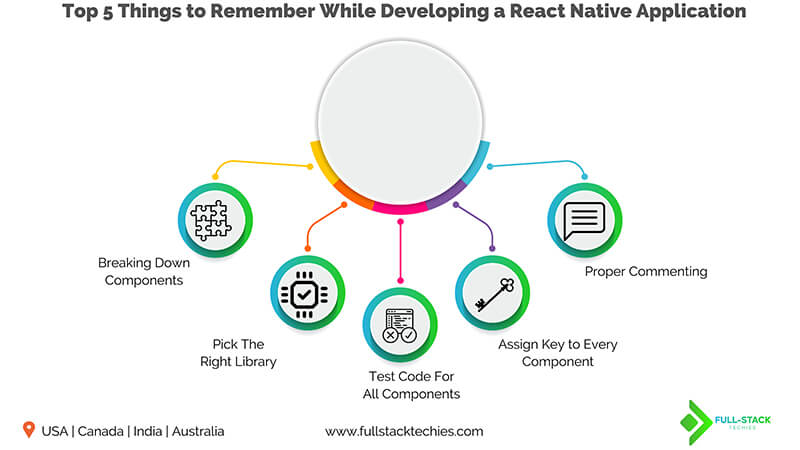Top 5 Things To Remember While Developing A React Native Application
React Native is an open-source language based on the JavaScript framework. It was made open-source by the developers of Facebook, where you can build apps on various platforms like Android, iOS, and other web applications using the same code base.
Google frequently removes low-quality material from its app store, so the actual number of applications keeps fluctuating. If you want to make a mark with your Android app, then you need to have a brilliant mobile app idea and access to the team that can provide life to that idea. Developing an Android app means entering into a new world of tough competition. One mistake can cost you the game.
Your app may be innovative in terms of concept, but if there isn’t a market demand for it, you’ll struggle to attract downloads. Your journey of launching a successful business app starts when you hire an Android coder. The right app development team can help you expand your foot in the market. If you choose to hire an Android developer from India, you’ll be provided with world-class Android app development services.
React Native is especially useful for developing mobile applications. That is why working with a react native app development company can help in new developments.
The main logic of an app built on React Native framework is that it can be shared on a web app, mobile app, and desktop app.
One of its biggest pros is that this language shares almost 96% of the code for apps between Android and iOS.
Therefore, apps built in react-native look similar on both android and iOS. Since React Native does not reply on webviews, therefore, this language is one step ahead of its competitors like Flutter and Ionic. It is built from actual components provided by the native platforms.
Another significant advantage of this language is its built-in access to native vies and components. It can also utilize native-written code and even allow API access to OS-specific features inside the app. Thousands of applications are built on React Native, including Fortune 500 companies. 14.85% of installed apps are built with React Native in the US. This makes this language the 3rd most popular programming language in the country. Mobile applications like Facebook, Instagram, Shopify, Discord, Skype, and Pinterest use this application. So, to build a functioning application using this language, it is important to understand certain components first.
Let’s look at the top 5 things to remember while developing a React Native application:
React Native is a useful framework that uses JavaScript to develop an app’s interface. You can use Facebook’s JavaScript library can be used to build user interfaces targeting mobile platforms. You can not only develop an app faster but also ensure enhanced performance as compared to cross-platform solutions. This programming language incorporates the concept of “bridge,” allowing asynchronous communication between the JavaScript and Native elements. This creates significant flexibility in using this language.
According to Stacks Developer Survey 20201, 14.51% of the developers prefer React Native as the programming language to intensive application development.
All the added advantages make React Native a suitable choice for app development. Choose a trusted react native app development company for your app development among the numerous react native companies. It is crucial to remember the major reasons while developing a React Native application. Keep these five factors in mind when developing such applications.
1. Breaking Down Components
Components are the fundamental building blocks of React applications. That’s why it’s wise to break down the primary component into two parts when writing logic for an app that can be used across platforms. You can break it down into two directories known as components and containers. A good react native app development company understands the importance of this factor when crafting a React Native application.
The first part is the presentation component responsible for how the application will look to the end-user. These components render a view as per the style of information and data passed. They usually do not have any internal changeable properties. The second part is known as a container component. It contains the main logic behind the presentation component, i.e., it defines the process of how the view reacts to user interaction. Container components have access to the store, and they can make API calls, conduct processing, and contains the business logic of the app. The second component is an integral factor since it is responsible for the heavy lifting as it passes down data to the presentational components.
2. Pick The Right Library
One of the key aspects you need to keep in mind while crafting a React Native application is picking the right library that will support your app. Since React is an open-source JavaScript library, you get two choices. An exceptional react native development company such as Full-Stack Techies can choose the right library to do your app justice. The two libraries available are JavaScript native library, and the other is the native library.
Most react native companies prefer the JavaScript native library because it’s easier to set up. With this library, you can build faster websites from scratch and get creative. With JavaScript native library, you can handle data, user interface, charts, and diverse UI components. You can easily develop simple code and implement React JS.
On the other hand, the native library is more oriented toward performance. This is because it has more feasible platform compatibility with iOs, Android, and even Windows, allowing app developers to their full potential. There are also various free libraries such as Enzyme, and Mocha Jest to choose from. These can help monitor the progress of your app and its features. Thus, pick the one that suits your requirement and supports your application development process from the very start.
3. Test Code For All Components
To ensure your code runs properly, you need to develop test code for all components when developing a React Native application. This will help you maintain the functionality of the existing code and eliminate the possibility of errors in the later stages. In React Native, you can build your code as per functionality and divide it into components. It is a practical decision to write tests when creating any new component. Most importantly, writing the testing code component-wise is a good practice as it helps you make your testing process more streamlined. You can test React Native apps using Snapshot tests and Redux tests.
When you do snapshot tests, you make sure the components are not broken up. This testing process also assists the developer in overviewing the UI changes introduced in the code to develop it further. Many react native companies implement Redux texts since they are predictable and help maintain the current code’s stability. Using this specific test process, you can aim for 100% code coverage where you can enhance the architecture. It is ideal to keep a test directory for each component to maintain a record of all the tests. So, take the help of a sustainable react native app development company for a seamless app development process.
4. Assign Key to Every Component
React Native gives you the option of assigning unique keys to all the components in a list. These unique keys can identify which items are altered, added, or removed. Reply on Full-Stack Techies; the best react native app development company that knows how to efficiently assign keys to the components when developing a React Native application. The process of assigning keys can be done by defining a string that can identify an item in a list in a unique way. The best possible way to identify and assign keys is o use IDs from the item list.
Keys are significantly helpful in lists. This is because when crafting an application, there will be different components, and having lists helps specify the tasks. Lists are usually performance-heavy, due to which assigning unique keys simplifies the process. However, you should also remember that new keys should not be added to objects in the code without proper evaluation. That’s why you can use the “|” symbol to create Exact object types. It ensures stable style safety so that new keys cannot be added to an object. It is also recommended not to use indexes as keys since it can negatively impact the app performance leading to unstable component behavior.
5. Proper Commenting and Naming Convention
Attaching proper comments on your code make it easier to understand and read when building a React Native application. Due to this, it is important to use a proper code commenting method to present the functionality of the specific code. As an outstanding react native development company, Full-Stack Techies incorporates an efficient approach to commenting. It is crucial to note that you should only put a comment when required. Otherwise, it can cluster the code leading to its instability. A good react native app development company understands the difference between proper commenting to avoid potential conflicts between the code and comment.
Another chief factor you should keep in mind when developing a React Native app is establishing a proper naming convention. Any class, function, or variable should be named properly and avoid duplication to ensure the problem does not arise. That’s why you need to name the components as per the instructions in JavaScript to avoid confusion. When you employ a dependable react native app development company, they know they need to avoid duplicate code. This impacts the naming process positively, elevating the overall app development process.
Conclusion
Like any other language or framework, React Native has its pros and cons. Developing apps using this programming language is quite easy, and it helps in cutting costs for various projects. Since the app is compatible with both iOS and Android and uses the same codebase, it massively lowers your development and maintenance costs. A feasible react native development company can successfully deliver mobile apps with a well-developed framework feasible for customers.
Although React Native doesn’t support Image, View, or Text Style Props, it can be used to develop a functional user interface. This programming language also doesn’t have Document Object Model (DOM) elements and percentage values. However, you can scale up your apps from different devices, convert web projects into mobile and also use interactive animations. With the practices mentioned above, your experience developing an app in React Native will be smooth and hassle-free. Engage with Full-Stack Techies; the react native app development company you can count on.
Related Articles
Why is C# web development still relevant in 2024
Why is C# web development still relevant in 2024?Web development has come a long way since the early days of the internet, but one thing that has remained constant is the enduring relevance of C# in the world of web development. As we head to 2024, you may wonder why...
Why Do Businesses Need Full-stack Developers To Stay Ahead In The Legalized Sports Betting And Marijuana Market?
Why Do Businesses Need Full-stack Developers To Stay Ahead In The Legalized Sports Betting And Marijuana Market? In recent years, several states in the USA have legalized sports betting and the use of marijuana in some form. To take advantage of these growing markets,...
How Python became a top programming language & Django became a popular framework?
How Python Became A Top Programming Language & Django Became A Popular Framework? Python is a commonly used programming language for a variety of purposes. It was created with the intention of being a general-purpose language that could be used for almost anything....



